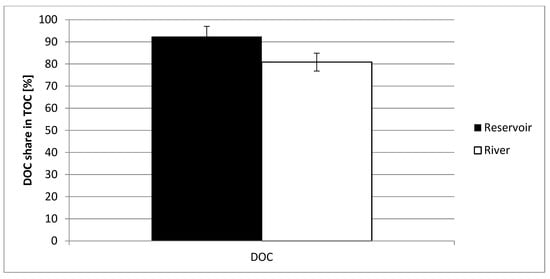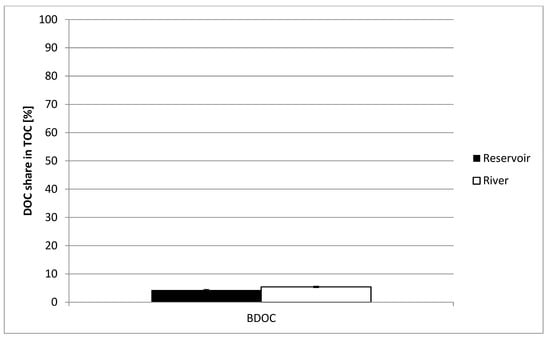Abstract
Total organic carbon (TOC) present in surface water consists of different fractions like dissolved organic carbon (DOC) or biodegradable dissolved organic carbon (BDOC). BDOC may have an impact on the bacteriological quality of water as it can be a source of carbon and energy for microorganisms. It is important to consider this parameter in case of the distribution of drinking water. The aim of this research was to compare the qualities of chosen surface water in Poland and Germany in terms of concentration of total organic carbon and its fractions. The samples were taken from the reservoir in Poland and Rhine River in Germany. The first one is a source of drinking water for humans. The research showed that, considering the analyzed compounds, the water from the river has better quality.
1. Introduction
Organic matter concentration in water may be described as total organic carbon (TOC) which consists of different fractions, e.g., dissolved or biodegradable form. Especially biodegradable dissolved organic carbon may be important when considering drinking water because of its impact on the bacteriological quality of water. It can be a useful source of energy for microorganisms and may be an essential parameter considering the distribution of drinking water. The aim of this research was the assessment of the concentration of total organic carbon and its fractions, i.e., dissolved organic carbon (DOC) and biodegradable dissolved organic carbon (BDOC) in surface water in Poland and Germany. A TOC analyzer was used to determine the concentration of TOC and its fractions [,].
2. Materials and Methods
Water samples were taken from the reservoir located in Silesian Voivodeship in Poland and Rhine River in Kleve, North Rhine-Westphalia state in Germany in the same season (winter). There were six samples taken from both, the river and the reservoir at the same place during six weeks (one sample once a week). The reservoir belongs to Upper Silesian Water Supply Company and was built over the period of 1935 to 1939 and adapted to water supplying in 1948 to 1951. The area covers approximately 6 km2 and its volume is about 17 M m3. It is the source of drinking water for few major Upper Silesian cities [,,]. Rhine is a major European river with length of 1233 km (865 km within Germany borders). Its catchment is inhabited by 50 million people and the river itself is considered highly contaminated [].
TOC concentration in the water samples was determined with the use of a TOC analyzer Multi N/C 2100. Fifty milliliters of each sample was taken for this purpose. Then, 0.45-µm membrane filters were used to pass the water samples for DOC determination. The Joret method was applied to analyze the concentration of BDOC [,].
3. Results and Discussion
The results of TOC concentration and its fraction in analyzed water samples are presented in Table 1.

Table 1.
TOC, DOC and BDOC concentration in water samples.
TOC concentration in the water sample taken from the reservoir amounted to 8.747 mg/L. In case of DOC, it was 8.083 mg/L and the BDOC concentration amounted to 0.350 mg/L. The concentration of TOC in the water sample taken from the Rhine was lower by about half and it amounted to 8.747 mg/L. The DOC concentration in this sample amounted to 3.336 mg/L and BDOC to 0.181 mg/L. In Figure 1, DOC share in TOC in both cases, the reservoir and the river are shown.

Figure 1.
DOC percentage share in TOC.
In case of water samples taken from the reservoir, the dissolved organic carbon is about 92% of total organic carbon. The water sample taken from the river DOC makes up to 80% of TOC. In Figure 2, BDOC share in DOC in both cases, the reservoir and the river are shown.

Figure 2.
BDOC percentage share in DOC.
In case of water samples taken from the reservoir, biodegradable dissolved organic carbon is about 4% of the dissolved organic carbon. In the water sample taken from the river, BDOC makes up to 5% of the DOC.
4. Conclusions
TOC, DOC and BDOC in water samples showed that all of the analyzed compounds have about twice as high concentration in the water samples taken from the reservoir despite the fact that the river itself is considered highly contaminated and is not the source of drinking water for human consumption (in the sample taking point).
Author Contributions
P.S. and A.R. conceived and designed the experiments; P.S. performed the experiments and analyzed the data; A.R. contributed reagents/materials/analysis tools; P.S. wrote the paper. All authors have read and agreed to the published version of the manuscript.
Acknowledgments
The research was supported by BS/MN 402-301/18 and BS/MN 400-301/19.
Conflicts of Interest
The authors declare no conflict of interest. The funding sponsors had no role in the design of the study; in the collection, analyses, or interpretation of data; in the writing of the manuscript, and in the decision to publish the results.
References
- Nawrocki, J. Water Treatment, Part 1; Scientific Publishing House PWN: Warszawa, Poland, 2010. (In Polish) [Google Scholar]
- Rosińska, A.; Rakocz, K. Role of biodegradable organic matter in water disinfection process. Environ. Eng. Prot. 2013, 16, 511–521. (In Polish) [Google Scholar]
- Rosińska, A.; Dąbrowska, L. Enhancement of coagulation process with powdered activated carbon in PCB and heavy metal ions removal from drinking water. Desalin. Water Treat. 2016, 57, 26336–26344. [Google Scholar] [CrossRef]
- Information Materials of Upper Silesian Water Company on Kozlowa Gora Water Treatment Plant. Available online: https://www.gpw.katowice.pl/stacja-uzdatniania-wody-kozlowa-gora.php (accessed on 3 March 2019). (In Polish).
- Information Materials of Upper Silesian Water Company on Kozlowa Gora Reservoir. Available online: https://www.gpw.katowice.pl/zbiornik-wody-kozlowa-gora.php (accessed on 3 March 2019). (In Polish).
- Mani, T.; Hauk, A.; Walter, U.; Burkhardt-Holm, P. Microplastics profile along the Rhine River. Sci. Rep. 2015, 5, 17988. [Google Scholar] [CrossRef]
- Dąbrowska, L.; Ogrodnik, A.; Rosińska, A. Effect of the Efficiency of Organic Matter Removal by Coagulation on THM Concentration in Chlorinated Water. Ann. Set Environ. Prot. 2016, 18, 455–467. (In Polish) [Google Scholar]
Publisher’s Note: MDPI stays neutral with regard to jurisdictional claims in published maps and institutional affiliations. |
© 2020 by the authors. Licensee MDPI, Basel, Switzerland. This article is an open access article distributed under the terms and conditions of the Creative Commons Attribution (CC BY) license (https://creativecommons.org/licenses/by/4.0/).